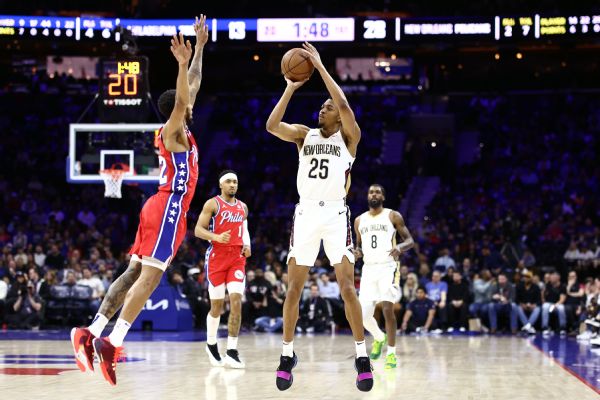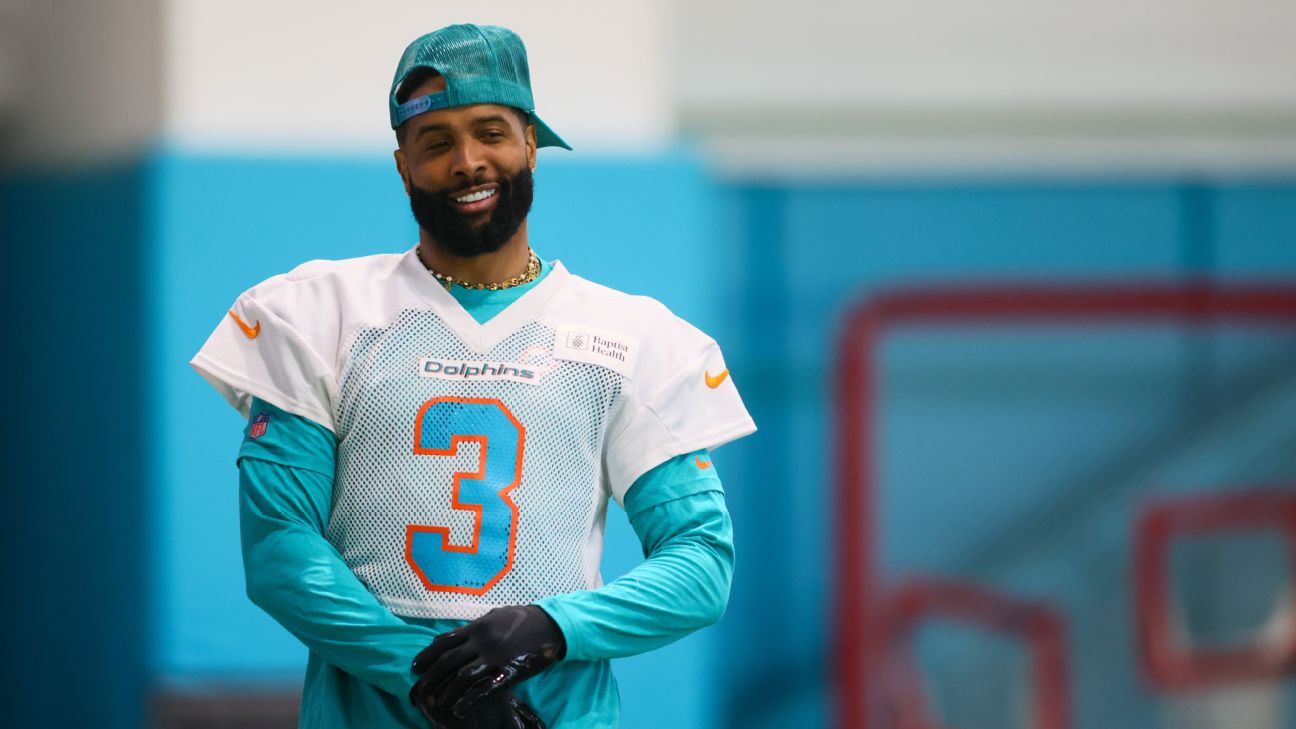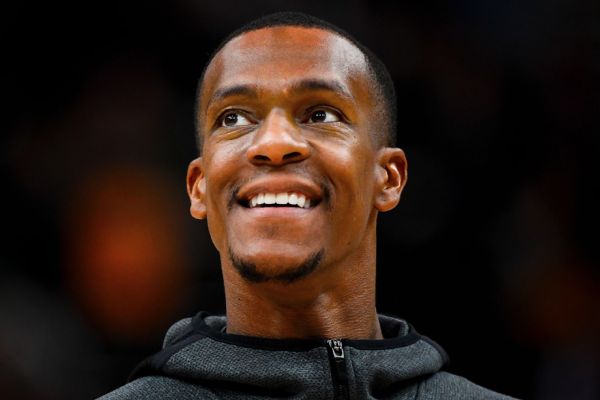![Travis Hunter [608x342]](https://a.espncdn.com/photo/2024/1003/r1395695_608x342_16-9.jpg)
Chelsea make winning start to Conference League
The word "unique" is overused when evaluating college prospects, but it's the perfect descriptor of Colorado junior Travis Hunter, who has established himself as an elite player at wide receiver and cornerback. And because of that two-way ability and his immense talent, he's arguably the most fascinating player in the 2025 NFL draft.
Hunter, the No. 2 overall recruit in the 2022 ESPN 300, shocked many when he chose to play for Deion Sanders at Jackson State. He followed Sanders to Colorado in 2023, where he caught 57 passes for 721 yards as a sophomore while also adding 30 tackles, three interceptions and seven pass breakups on defense (despite missing three and a half games due to a lacerated liver). Now he has upped the ante this season, already compiling 46 receptions for 561 yards and six touchdowns in five games on offense, plus 18 tackles, two interceptions and a forced fumble defensively.
Hunter is the only FBS player in the past 30 years with at least 10 career touchdown receptions and five interceptions, per ESPN Research. He's also the first player since Aqib Talib in 2007 to record a touchdown reception and an interception in multiple career games. And he has played 620 snaps this season -- 320 on defense and 300 on offense -- which is 251 more than the next highest FBS player.
All of this has Hunter generating top-10 buzz for the April draft. But where does Hunter fit best at the next level? Is he a wide receiver? Cornerback? Could he play on both sides of the ball? NFL draft experts Matt Miller and Jordan Reid spoke with more than a dozen scouts and coaches to dig into Hunter's best pro position, draft stock, standout traits, areas where he can still improve and even a few team fits.
Jump to: WR projection | CB projection Best position fit | Two-way potential Best NFL team fits
How does Hunter project as a pro at wide receiver?Miller: Hunter is electric. That's the best word to describe his rare ability as a wide receiver. At 6-foot-1 and 185 pounds, he has a lean body type, but it's loaded with muscle and suddenness that allow him to glide around defenders. His 11 forced missed tackles after the catch are tied for seventh in the nation. He also has the speed to run past defensive backs. He shows instincts for finding space, has great timing for attacking the ball and is fearless when asked to make a play in traffic. And the wild part: He's still learning the position.
"Even if you take away what he does on defense, I think he's the best player in college," an AFC general manager said.
Hunter is eighth in the nation with 112.2 receiving yards per game this season. He is the focal point of the pass-happy Colorado offense, seeing a target share of 30%. And it's likely that Buffaloes quarterback Shedeur Sanders feels comfortable looking his way early and often because Hunter is so sure-handed. He has just one drop this season on 57 targets.
"He's a unique prospect," an AFC South area scout said. "He's really good at both positions ... but he can be a good wide receiver immediately. Not a true WR1 right away, but a good WR2 all day. And with his work ethic, if he wanted to, he'd be great."
There is playmaking ability and savviness to his game that stands out watching tape. Want to see his after-the-catch traits and speed? His first score against North Dakota State in Week 1 is a shake and bake of a cornerback after a 4-yard pass from Sanders. Hunter juked his man and raced 37 yards to the end zone.
Looking for craftiness? In the third quarter of that North Dakota State game, Hunter ran a go route down the right sideline. Sanders led him upfield and Hunter used a subtle extension of his left arm to keep the Bison cornerback out of his hip pocket. It was a 40-yard gain in a tight contest. Later on that same drive, Hunter scored on a 13-yard post corner route, his second of three TDs that night.
Hunter's pro projection -- in my evaluation and in conversations with scouts -- is that he's a work in progress given his dual focus. If he becomes a receiver, his rookie season will see him largely work as a No. 2. An NFL scheme that can get receivers in motion before the snap for free releases -- like what we see with the Dolphins and 49ers -- is likely best for him in terms of contributing out of the gate. Those Shanahan-style systems will get the ball in Hunter's hands and allow him to make defenders miss in space.
Hunter is also probably better off starting out in the slot, where he wouldn't be routinely expected to beat press coverage. At Colorado, he worked primarily in the slot in 2023 (213 routes out of the slot vs. 99 outside), but he has been outside most of this season. He has run 185 routes split out wide compared to 30 inside. But as far as the route combinations and the route tree go, this isn't a pro-style offense. That's one of the biggest complaints scouts have watching his tape on offense.
"So much of what they do is just him and Shedeur playing backyard football," an NFC college scouting director said. "It's 'go get open and I'll throw it to you' instead of a nuanced offense."
Hunter will have much to learn in the NFL. But the skills are all there for him to be a very good receiver early in his NFL career.
"What stands out most to me is his penchant for being in the right place at the right time. He's tough as hell, he's incredibly fast, but his instincts as a playmaker are a blue-chip trait," another AFC general manager said.
And how does he project as a pro at cornerback?Reid: For as good as Hunter has been at receiver this season, one could make a strong argument he has been even more impactful as a corner. He has the potential to be a true CB1 at the next level. While he can play in the slot and outside, his best projection is on the perimeter because of his length, vertical speed and ability to take away throwing windows.
With loose hips and great movement traits, Hunter can open, turn and run with receivers. He seemingly has a sixth sense for knowing where the ball is in the air, and his body control and hand-eye coordination help him make plays on it. He has five interceptions and 10 pass breakups over his Colorado career.
"He's like a center fielder out there when he sees it in the air," a West Coast area scout for an AFC team said.
Hunter's interception against UCF in Week 5 is a great example of his fantastic awareness in zone coverage. He baited quarterback KJ Jefferson into an underneath throw and then drove on the ball to make a diving pick. That type of closing speed is uncommon for a college corner.
I see easy straight-ahead speed on tape, too, as Hunter is hardly ever beaten down the field. Wide receivers have run vertical routes on him 27 times this season, but opposing quarterbacks have only tested him twice on those routes. Both resulted in a breakup.
"If you watch him, all of the catches he's given up come underneath because you're not beating him deep," an NFC assistant general manager said. "Now imagine his ceiling once he really focuses on and sharpens the detail of actually playing the position and not just [playing] off of his natural ability."
There are things he needs to work on in coverage, though. As the assistant GM suggested, Hunter still relies heavily on his physical traits and speed on the perimeter, which can hurt him when attempting to stay attached in man coverage. His technique must improve at the next level -- playing that way will get him into trouble against NFL-caliber receivers. We're already seeing evasive and physical route runners presenting problems for him. He has allowed a 58.8% completion percentage as the primary defender on passes thrown into his coverage this season.
"Hunter's just too grabby at times right now because he's playing strictly off of his natural ability," an AFC area scout said. "When he guesses wrong, his first instinct is to grab ahold of his matchup, which will draw flags on the next level."
Perhaps his biggest defensive impact play of the season wasn't even in coverage. In Week 4 against Baylor, the Buffs were up 38-31 in overtime, and the Bears had quickly moved the ball down to the Colorado 2-yard line, trying to tie the score. But on first down, Dominic Richardson was met by Hunter at the goal line. Hunter lowered his shoulder and popped the ball loose for a huge game-sealing forced fumble.
Coming into the season, scouts wanted to see more willingness to tackle. Hunter has taken steps forward there, with key plays like that as evidence. His tackling consistency and intensity remain a work in progress, though; he has 18 total tackles but has missed three.
So where does Hunter project best in the pros?Miller: Wide receiver. We've seen Hunter make exceptional plays on both sides of the ball this season. He has double the receptions of Colorado's No. 2 receiver and has been an eraser at cornerback. But his long, lean frame might make him a better fit on offense, where he can better avoid contact and dictate impact. That's how to get the most production and career longevity out of him.
Hunter currently ranks as my No. 3 overall prospect and No. 2 wide receiver, behind Missouri's Luther Burden III. In scouting parlance, his ceiling is higher than Burden's, even if his floor isn't quite as high right now.
"That guy can play whatever he wants," an AFC East area scout said. "[But] I think the way the league is going -- with wide-open offenses -- I think you put him at wide receiver."
Another NFL general manager who has scouted Hunter in person agreed wide receiver is his future. "I watched him live, and his movement and ball skills combo [were] rare. I think he projects higher at wide receiver. ... His frame and tackling demands would be the place to nitpick [at cornerback]."
It may also come down to what Hunter prefers to play, but there's no denying what he'd bring to an offense, especially factoring in the growing importance of the position. Financial implications could play a part. There are 12 wide receivers making more annually than Jalen Ramsey, the NFL's highest-paid cornerback at $24.1 million per year. And there are 23 receivers making at least $20 million per year, as opposed to five cornerbacks.
Reid: After going back and forth on this a bunch of times, I actually like him more at corner, though I have him ranked as the No. 1 prospect at both positions. Yes, the financial aspect of playing wideout will be brought up, but it's defense where he could have the biggest impact.
If I were a general manager who just used a top-10 pick to land Hunter, my primary goal would be getting him on the field for as many plays as possible. Cornerback might be the best way to do that. And in a league that seems to be producing high-end early-round receiver talent every year, finding dependable cornerbacks is more important than ever before. It's hard to find an impact CB like him.
"He's a good player on both sides, but his upside at corner is tremendous," an NFC South scout said. "You also have to remember, he's not even practicing that much throughout the week because they are saving him for Saturdays. Imagine where he'd be if he was working at it on a day-to-day basis."
The player I compare Hunter to the most is Champ Bailey, the No. 7 pick in 1999. Sizing up Hunter against a Hall of Fame player is high praise, but their college careers are nearly identical. During Bailey's final season at Georgia in 1998, he had at least 100 snaps in seven games, playing both sides of the ball. He was known for his ball skills and toughness as a corner, and because he was consistently the best athlete on the field, Georgia wanted to use him at receiver, too. But when it came time to go pro, Bailey became a full-time corner. (He did have a rushing TD in 2000, though.) Ultimately, I see a similar scenario for Hunter.
Is there a chance Hunter could play both ways in the NFL?Miller: Hunter is a special player, so betting against him wouldn't be wise. But let's look at this historically. Two-way players from college have not become two-way players in the NFL. Charles Woodson is perhaps the most famous two-way player of the past 30 years, but he only caught two passes in his 18-year NFL career. Bailey was a star on both sides at Georgia but had four receptions in 15 professional seasons. Myles Jack, Chris Gamble and Devin Hester are other examples that point to a precedent of NFL franchises not wanting to expose superb two-way players to extra hits or extra snaps that could lead to injury.
So will Hunter be any different? Could he play a few snaps at cornerback per game while primarily playing wide receiver? Or vice versa? It's possible, especially early in his career. But it's not likely Hunter becomes a full-time Iron Man player.
"To think he will be the best receiver and the best cornerback is kind of foolish," an NFC defensive backs coach said.
Early first-round picks are among an NFL team's most valuable assets. Those players are expected to be early starters, foundational building blocks and future Pro Bowlers or All-Pros. And with Hunter projected to be a top-five or at least top-10 pick, it's quite obvious he'll be asked to pick an NFL position once drafted. Or perhaps one will be assigned to him by his drafting team based on its needs and roster construction. The risk involved with asking him to play both ways is simply too great for a first-round investment.
"I wouldn't want to expose him to the shoulder issues of a tackler, full-time," an AFC college scouting director said. "We're not talking about a 200- or 210-pound guy."
An NFC West area scout who has evaluated Hunter in person agreed. "I think he could be a top-five corner, but this is an offensive league, and the money is being spent on that side of the ball. I don't see why you'd ask a player with his potential to play defense and risk injury."
Hunter has played more than 115 snaps in each of his five games this season, including 137 against Baylor in Week 4. That was the most snaps of any college player in a game this season and the third-most by any FBS player in the past two seasons. The top two? Hunter's 143 against Stanford and 139 against TCU, both coming last season.
Those totals are way above the NFL standard; Indianapolis Colts linebacker E.J. Speed leads the league this season with 80.5 snaps per game. It's a testament to Hunter's conditioning and love of the game, but again, it's not realistic to expect him to carry that same snap count moving forward.
"You love his work ethic and his want to play every snap, but this is the NFL and not the Big 12. The starting cornerbacks at this level are really good. The starting receivers are really good," the NFC defensive backs coach said. "He's a great player in college, but the time it takes to be great at one position in the NFL is massive. Focusing on two positions will ultimately hold him back from being very good at one of them."
Which NFL teams could make sense for Hunter?Reid: In a class lacking high-end talent at the top and featuring a QB crop still sorting itself out, there's a realistic chance Hunter could be the first player selected. A cornerback has never been drafted No. 1 overall, and Keyshawn Johnson (1996) was the last receiver selected with the top pick. But Hunter is currently my No. 1 overall player, and it'd be hard for me to move him out of that spot based on how well he has played this season.
"I love him in New England," an NFC East area scout said. "Yes, they have issues to address up front for the young quarterback [Drake Maye], but I'm not taking any of these offensive tackles as high as they will be picking."
Adding a talented playmaker like Hunter would provide Maye with another option at receiver alongside this year's second-round pick, Ja'Lynn Polk. Or on defense, the Patriots could pair Hunter with 2023 first-round pick Christian Gonzalez to form a great cornerback duo. The 1-3 Pats currently have a 16.2% chance to land the top pick, per ESPN's Football Power Index projections. Only the Dolphins have better odds.
Another team that makes a lot of sense? The Carolina Panthers, who are also 1-3 and have a 10.2% chance to land the No. 1 pick.
"Outside of [defensive tackle] Derrick Brown, I don't see any star-caliber type of players at any spot on that roster," an AFC scouting director said.
Hunter would give the Panthers someone to build around. They have traded away star players Christian McCaffrey and Brian Burns in recent years, so Hunter would have the potential to become the face of the franchise rather quickly.
"Put him anywhere and he's a fit," an NFC assistant general manager said. "He's just that special."







